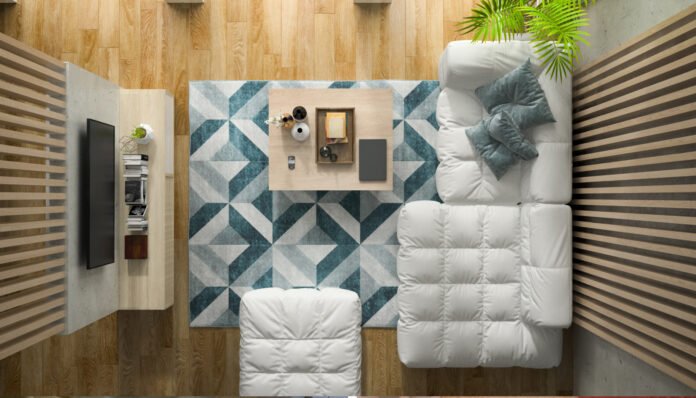Living in a small apartment doesn’t mean you have to sacrifice style or comfort. I learned this the hard way after moving from a spacious suburban home to a 600-square-foot apartment in the city. At first, I felt like the walls were closing in, but after some trial and error (and yes, a few frustrated IKEA trips), I discovered that small space decor is more about creativity than limitation.
In this guide, I’ll share the tricks that saved my sanity and transformed my tiny apartment into a space that feels both functional and personal. No more bumping into furniture or feeling cramped—these solutions actually work!
Understanding the Challenges of Small Space Living
Anyone who’s lived in a shoebox apartment knows the struggle. You want your home to feel cozy, not claustrophobic. You need storage, but don’t want to be surrounded by clutter. And somehow, you’re supposed to fit living, sleeping, and working areas into one tiny footprint.
Common Pain Points in Apartment Living
The challenges of small spaces go beyond just feeling cramped. Here are the issues I struggled with most:
- Storage limitations that led to constant clutter—I was forever tripping over shoes in my entryway.
- Lack of distinct zones for different activities
- The feeling that every inch needs to be functional, leaving little room for personality
- Restrictions from landlords about making permanent changes
My neighbor Tom summed it up perfectly: “Living in a small space isn’t just about having less room for stuff—it’s about rethinking your entire relationship with your possessions.”
The Psychology of Space and How It Affects Mood
What surprised me most about living in a small space was how much it affected my mindset. Studies show that our environments significantly impact our mental well-being. Clutter and cramped conditions can trigger stress responses and make us feel less in control.
When I first moved in, I felt anxious whenever I was home. However, after implementing thoughtful small space decor solutions, my apartment began to feel like a sanctuary rather than a cage. The key was creating a sense of order and intentionality with everything I brought into my space.
“It’s not about having less, but being surrounded only by things that serve a purpose or bring you joy.” – This became my mantra during my small space transformation.
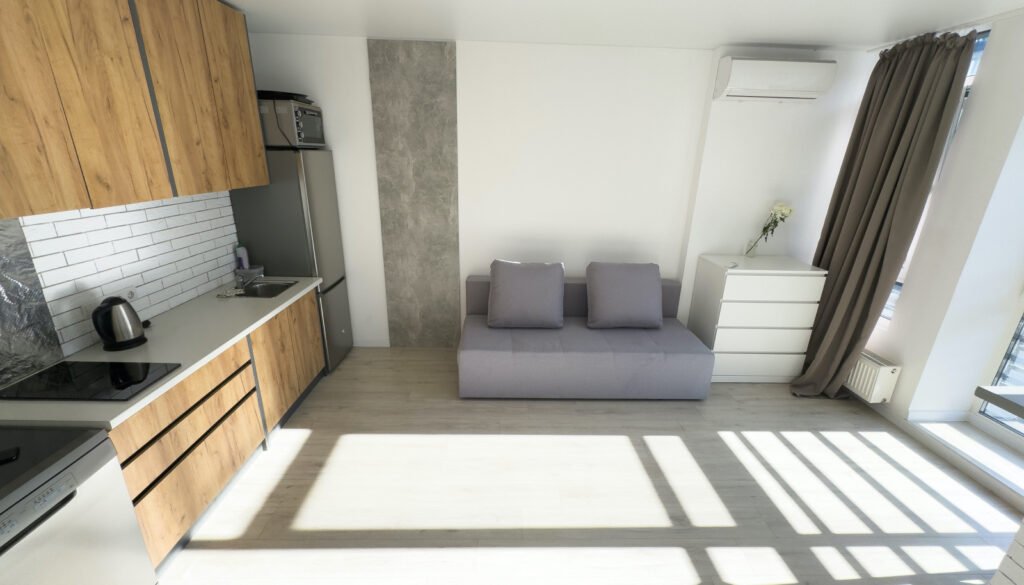
Multi-Functional Furniture: The Small Space Dweller’s Best Friend
If there’s one lesson I’ve learned, it’s that in small apartments, every piece of furniture should earn its keep by serving multiple purposes.
Convertible Pieces Worth Investing In
After blowing my budget on a beautiful but ultimately impractical sofa, I learned to prioritize function alongside form. These multitasking heroes have made the biggest difference in my space:
- Sofa beds with storage underneath—mine hides extra bedding and seasonal clothes.
- Nesting tables that can spread out when you have guests
- Ottomans with removable tops for hidden storage
- Drop-leaf tables that can expand for dinner parties
- Murphy beds that disappear into walls or cabinets
My most worthwhile investment? A storage ottoman that serves as a coffee table, extra seating, and houses all my crafting supplies. At $120, it wasn’t cheap, but it replaced three separate items I would have needed otherwise.
DIY Hacks to Transform Existing Furniture
You don’t always need to buy new furniture to make your space work harder. Sometimes, a little creativity can transform what you already have:
- I added casters to my heavy bookshelf so I could move it easily, creating a flexible room divider.
- Small space decor often requires thinking vertically—I installed a simple pipe shelf above my desk for additional storage.
- An old dresser became my TV stand with additional storage when I removed the top drawers and added a shelf.
My friend Sarah, who lives in a 450-square-foot studio, turned an IKEA kitchen cart into a movable bar/food prep/work-from-home station that she wheels around her apartment as needed. “It’s like having an extra room that follows me around,” she jokes.
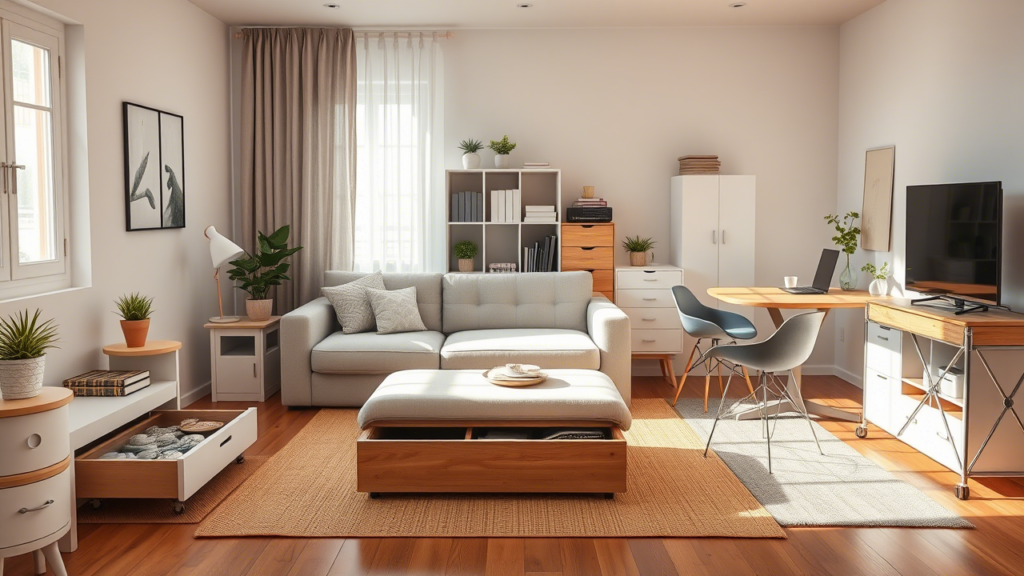
Vertical Space: Your Untapped Decorating Resource
When I couldn’t expand outward, I learned to look up. The walls and vertical spaces in your apartment are probably your most underutilized assets.
Wall-Mounted Solutions That Save Floor Space
My living room transformation began when I took a hard look at what was eating up my floor space. By moving things to the walls, I reclaimed valuable square footage.
- Floating shelves instead of bookcases
- Wall-mounted desks that fold down when not in use
- Small-space decor works best when you use wall-mounted lighting instead of floor lamps.
- Pegboards in the kitchen for cookware and utensils
I found that mounting my TV on the wall saved about 10 inches of depth that my old media stand took up. That might not sound like much, but in a small room, those inches made the space feel significantly more open.
Ceiling-to-Floor Storage Ideas
Don’t stop at eye level! Utilizing the full height of your walls maximizes storage without consuming precious floor space.
- Floor-to-ceiling bookshelves (I anchored mine securely to the wall)
- Hanging organizers on the backs of doors
- Under-shelf baskets in kitchen cabinets
- Over-the-toilet storage in bathrooms
My kitchen was particularly challenging until I installed tension rods between cabinets to hang cleaning supplies and added hooks underneath shelves for mugs and measuring cups. These simple additions doubled my storage without any permanent installations that might upset my landlord.
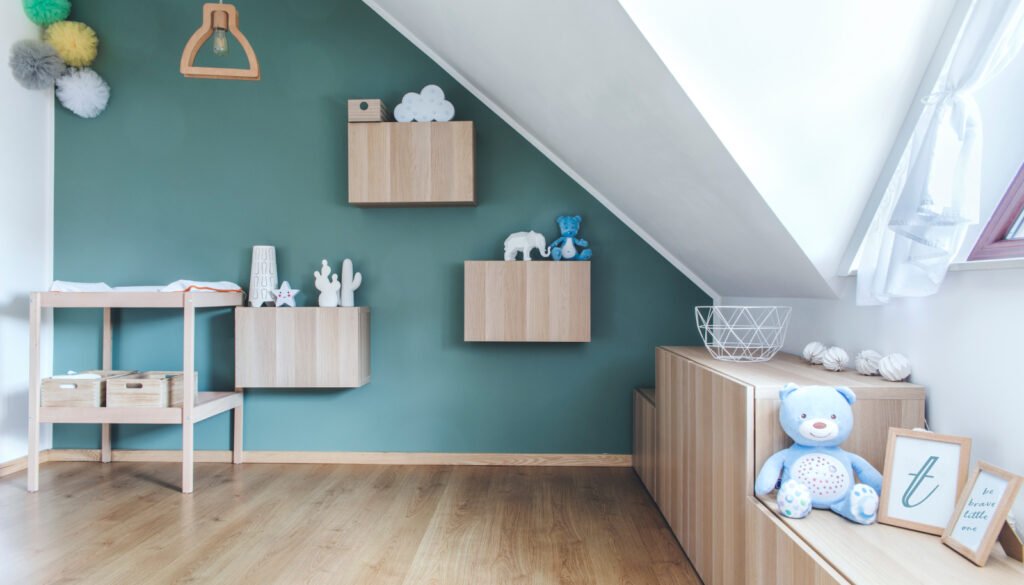
Creating Visual Space Through Color and Light
Sometimes, the most effective small space decor changes have nothing to do with furniture or organization—they’re about creating the illusion of space.
Strategic Color Palettes for Small Apartments
After painting my entire apartment bright white (a rookie mistake that felt clinical and cold), I learned some nuanced approaches to color:
- Light colors generally make spaces feel larger, but that doesn’t mean everything must be white.
- Creating a monochromatic color scheme helps small spaces feel cohesive.
- Using the same color for walls and trim removes visual breaks that can make a space feel choppy.
- Accent walls in darker colors can actually create depth, making the room feel larger.
The most transformative color change in my apartment? Painting my ceiling a pale blue. It draws the eye upward and creates the illusion of height and openness—almost like having a skylight.
Lighting Tricks That Make Rooms Feel Larger
Poor lighting can make even spacious rooms feel like caves. In my small apartment, strategic lighting has been crucial:
- Multiple light sources at different heights create dimension.
- Uplighting casts light on the ceiling, making small spaces feel taller.
- Mirrors placed opposite windows reflect natural light and visually double your space.
- LED strip lights under cabinets eliminate shadows in work areas.
I placed a floor lamp behind my couch that washes light up the wall, and the difference was immediate. The room suddenly felt twice as large because the boundaries of the space were less defined by shadows.
My splurge was replacing my standard-issue rental ceiling fixtures with simple pendant lights that better direct light where I need it. I kept the old fixtures to reinstall when I moved out.
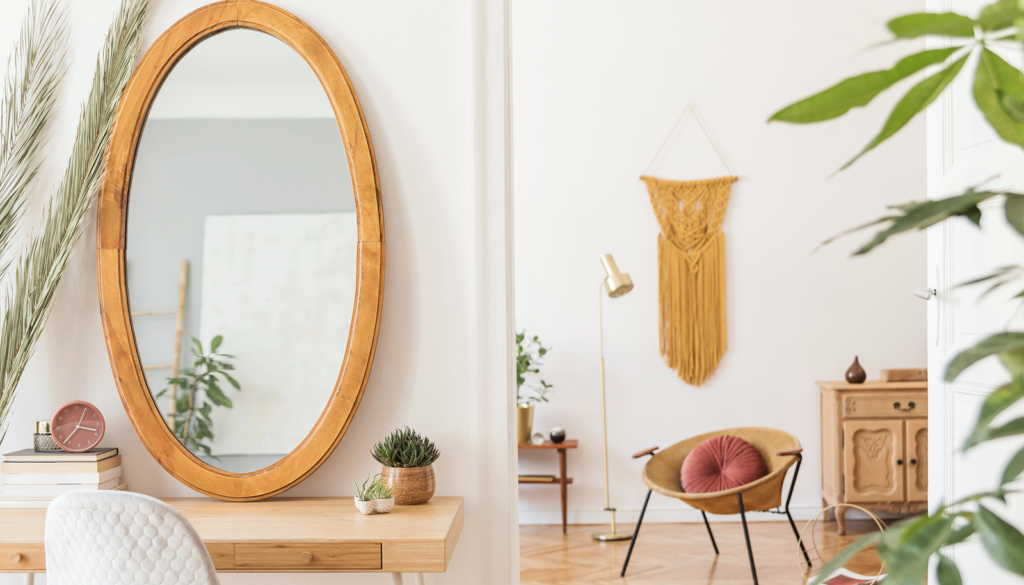
Smart Accessories and Decor That Won’t Overwhelm Your Space
When every square inch counts, you need to be ruthless about what decorative elements earn a place in your home.
Minimalist Approach to Decorative Elements
I used to be a collector of… well, everything. Moving to a small space forced me to be much more intentional:
- Choose fewer, larger pieces rather than many small items (which can read as clutter).
- Small space decor works best when each decorative item has significance.
- Rotate seasonal decor rather than displaying everything at once.
- Focus on quality over quantity.
My apartment feels most peaceful when surfaces are mostly clear, with just a few meaningful objects displayed. I now ask myself, “Does this item add enough beauty or joy to justify the space it takes up?”
Double-Duty Decor Items Worth Having
The best decorative elements in small spaces serve both practical and aesthetic purposes:
- Beautiful baskets that hide clutter
- Decorative trays that corral small items while adding style
- Attractive textiles that add warmth but can be easily changed
- Plants that improve air quality while adding life to your space
My favorite double-duty decor item is a large vintage map that I hung on my largest wall. It serves as artwork, a conversation piece, and cleverly hides an unfortunate thermostat and intercom panel that would otherwise be eyesores.
Tom, from next door, installed a gorgeous room divider made of hanging plants that not only separates his workspace from his living area but also improves his apartment’s air quality and acoustics. “It’s like having an extra wall that breathes,” he says.
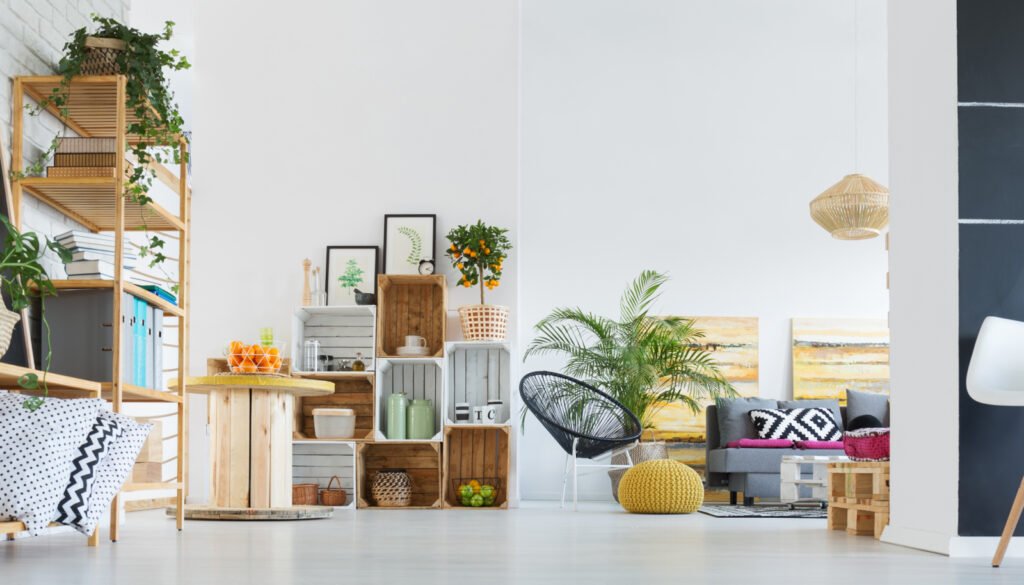
Bringing It All Together: My Small Space Transformation Journey
Looking around my apartment now, it’s hard to believe it’s the same space I moved into two years ago. By implementing these small space decor strategies, I’ve created a home that feels spacious, functional, and completely “me.”
The biggest lesson I’ve learned? Small-space living isn’t about deprivation—it’s about intention. Every item, every color choice, and every piece of furniture needs to earn its place. But when you get it right, a small space can actually feel more comfortable and personalized than a larger home filled with unnecessary stuff.
If you’re feeling cramped in your current space, start with one area that’s causing you the most frustration. Apply these principles there first, then move on to the next challenge. Before long, you’ll find yourself falling in love with your small space rather than feeling limited by it.
And remember—some of the most memorable homes in the world aren’t mansions but small spaces that perfectly reflect their owners’ needs and personalities.
FAQ: Small Space Decorating Questions
How can I make my small bedroom feel larger without removing furniture?
Focus on creating visual space through proper furniture placement (avoid blocking pathways), using light colors, and incorporating mirrors. Consider a bed with built-in storage to eliminate the need for a separate dresser and mount lighting fixtures on walls instead of using table lamps.
What are the best paint colors for making a small apartment look bigger?
Light, cool tones generally make spaces feel larger—soft blues, greens, and grays work well. However, don’t be afraid of darker colors as accents, especially when used on a focal wall behind a bed or sofa. The key is to maintain a cohesive palette throughout your space rather than breaking it into distinctly colored areas.
How can I create separate zones in a studio apartment?
Use furniture arrangement, area rugs, and lighting to define different functional areas. Room dividers like bookshelves, curtains, or even strategically placed plants can create visual separation without blocking light. Consider a loft bed with a workspace underneath if your ceiling height allows.
What’s the biggest mistake people make when decorating small spaces?
The biggest mistake is trying to fit too much into the space or using furniture that’s too large for the scale of the room. Start with only what you need, then add pieces intentionally. Remember that negative space (empty areas) is crucial for a room to feel balanced and uncluttered.
How can I entertain in my small apartment without it feeling cramped?
Focus on flexible seating options like floor cushions, folding chairs, or nesting stools that can be tucked away when not in use. Consider a drop-leaf or expandable table that can accommodate guests but doesn’t take up much space day-to-day. And remember—people enjoy the intimacy of a cozy space when it’s thoughtfully arranged!

